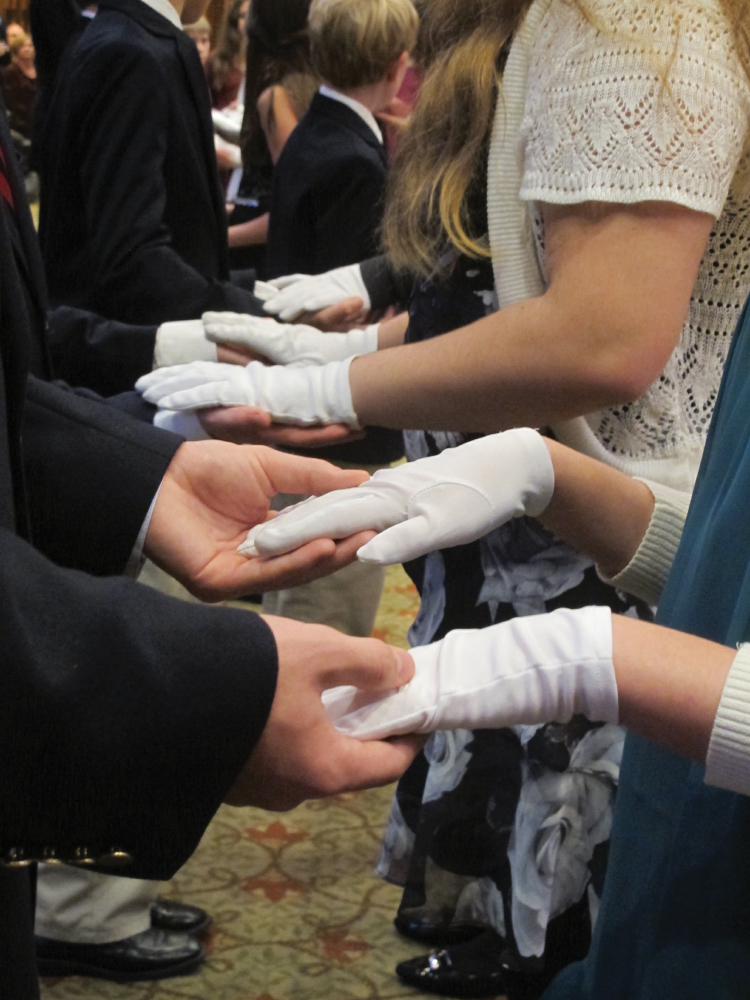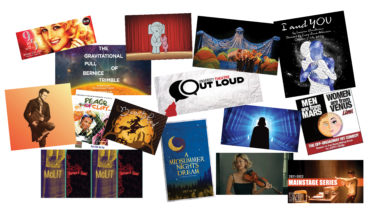For decades, this stalwart institution led by Yvette Shallcross and Cindy Oates has taught etiquette, dance — and confidence.
by Susanna Klingenerg
Pop quiz: You’re introducing your grandmother to a business associate. Whose name should you say first?
If you’re stumped, you’re certainly not alone. But it’s second nature to the graduates of the Raleigh Junior Cotillion, the city’s long-standing school of etiquette and ballroom dance. At the school — the largest local outpost of the National League of Junior Cotillions — fifth- through eighth-graders learn social graces and, in doing so, carry a rite of passage into the future.
Drop by North Hills Club on a Sunday or Monday evening during the school year and you’ll find a gathering in the ballroom that echoes centuries of tradition. Young teens sit in a circle, girl-boy-girl-boy, learning the same manners — with a few 21st-century updates — that their parents and grandparents learned before them. Time hasn’t changed the dress code: suits and ties for boys, dresses and wrist-length gloves for girls, with white dresses at the end-of-year Grand Ball. At first glance, the students aren’t much different either. They silently mouth “one-two-three, two-two-three” and squish toes during the waltz, eye the refreshments, and squirm. Kids are kids, after all, no matter the century.
But one important difference sets today’s cotillion students apart from their historic counterparts: in 2021, cotillion is almost entirely different from regular life. While parents and grandparents would have found the ritualized, tech-free classes and formal attire at least somewhat routine, it’s unfamiliar territory for most kids in this increasingly informal, fast-paced, and tech-driven society.
“We live in a drive-through culture,” says Cindy Oates, one of the Raleigh Junior Cotillion co-teachers. “Parents have these children in a million activities, and they rarely sit down for meals. Cotillion is just so different from anything else they do.”
“But honestly,” she continues, “we love that formality.” Her co-teacher, Yvette Shallcross, nods in agreement. Parents agree as well: Raleigh Junior Cotillion is a place apart, where details matter, tradition reigns, phones are tucked away, and kids can learn lessons not taught in school and hard to teach at home. Parents have been taking this approach for centuries: in the early days of American history, folks with the financial means would bring over experts from Europe to train their children in dance and social courtesies. These days, students master table manners (the basics, plus formal details like coffee service, dessert spoons, and shrimp forks), several ballroom dances, and etiquette, including for email and text messages. They also learn protocol for social scenarios, such as how to shake hands and make proper introductions.
(By the way: you’d say your grandmother’s name first, out of respect for her age and family ties.)
Carefully tailored curriculum aside, the leaders of Raleigh Junior Cotillion say etiquette isn’t really about ma’ams and sirs and shrimp forks. It’s about learning to navigate any social situation and to put others at ease, too. “They don’t realize at the time that they’re gaining confidence that will allow them to be comfortable,” says Shallcross.
Jack Pyritz, a 23-year-old cotillion graduate and mechanical engineer, confirms this: “How to write a letter, how to answer the phone properly… you get out into the real world and you don’t realize how many people don’t know how to do that stuff.”
Preparing young people for life beyond middle school is a well-practiced art for Oates and Shallcross. Dear friends outside the classroom, the two have been teaching cotillion together in Raleigh for 24 years. When Shallcross’ son was in cotillion, someone asked her if she’d be interested in teaching. She was, and when she recruited Oates, the pair jumped in headfirst, inheriting leadership of the well-established program, aligning the chapter with the National League of Junior Cotillion, and passing on their knowledge to a new batch of students. “We were scared to death at our first class,” says Oates. “We had our notecards, trying to read everything just right. When the children didn’t laugh at our jokes, we thought, Oh this is just awful! Then we realized they were nervous too.” Shallcross laughs: “We all got over our nerves together.”
It’s hard to imagine any situation that would make this pair nervous. With their warm demeanors and genteel drawls, Oates and Shallcross are the picture of confidence and grace. In the classroom, though, it’s not all perfect posture and pinkies up. Though the content they teach is mostly based in centuries-old tradition, their approach is distinctly contemporary. The pair encourage participation with elements of friendly competition and plenty of humor, to soften the edge of white-gloved formality. A lesson on table manners might include a slapstick demonstration on how not to use a soup spoon, for instance. Practice with the cha-cha might mean partners work together to hold a balloon between them while executing the steps.
Appealing to middle-school sensibilities is critical to their mission. Who else but an inspiring teacher could convince a 12-year-old to wrangle a formal place setting or persuade the shyest boy in class to escort his classmate to lemonade and cookies? Shallcross beams when she talks about her students’ progress from the first class to the Grand Ball at the end of the year: “When they show off what they’ve learned, their parents’ chins are on the floor!”
But if you were ever a cotillion student yourself, you know that learning those social graces can be a pretty ungraceful process. After all, it’s kids being asked to do grownup things (awkward) with their peers (embarrassing), occasionally in front of parents and their cameras (mortifying).
“It was definitely a little awkward,” remembers cotillion graduate Carlyle Kennedy, who is off to the University of North Carolina Wilmington this fall. “I’d just met all these new people and then I had to dance with them!” It wasn’t all bad though, she says: “The cookies were really good.”
__
This story originally appeared in our September 2021 issue.




